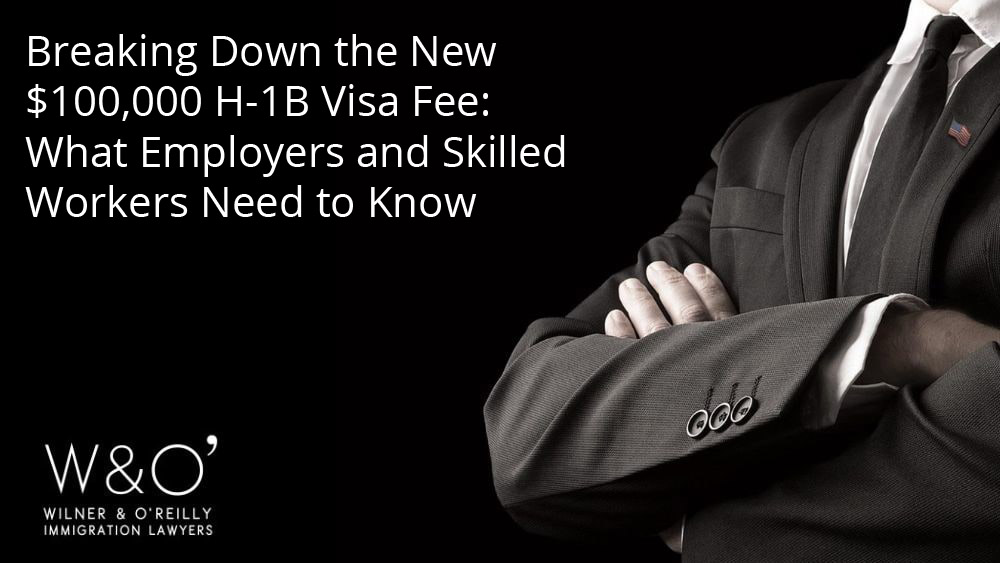A Historic Shift in H-1B Policy
On September 20th, 2025, President Donald Trump signed a proclamation that reshapes one of the most relied-upon employment-based visa programs in the United States. The new policy – which was to go into effect at 12:01am EDT on September 21st and remain in effect for 12 months unless renewed – requires employers to pay a $100,000 fee for each new H-1B petition, alongside heightened wage requirements and closer scrutiny from the Department of Labor (DOL).
For U.S. employers and skilled foreign workers, this is one of the most dramatic changes to the H-1B program in decades. Understanding who is impacted, what is still unclear, and how to prepare is critical for those navigating employment-based immigration today.
The Key Changes
– New $100,000 H-1B Petition Fee: Employers filing new H-1B petitions for workers outside the United States must now pay $100,000. It is unclear whether this fee replaces or adds to existing filing costs, which already include several thousands of dollars in government and compliance fees.
– Higher Prevailing Wage Requirements: The DOL will revise wage rules to ensure H-1B workers are paid above current market levels, further increasing employer costs.
– Greater Scrutiny in Adjudication: The administration has emphasized that the goal is to protect U.S. workers and target perceived misuse of the lottery system. As such, we can expect heightened scrutiny on future petitions, likely increases in Requests for Evidence, etc.
Who Is Affected — and Who Isn’t
– Affected: New or pending H-1B visa petition filings for foreign nationals outside the U.S. as of September 21, 2025. Employers seeking to bring new workers into the country under the H-1B cap or cap-exempt categories.
– Not Affected: Current H-1B holders already inside the U.S.; existing petitions filed before the proclamation date; certain workers deemed in the “national interest.”
– Unclear: Whether the $100,000 fee will be required of cap-exempt petitions, which have been treated differently; whether travel and reentry for current visa holders could trigger new payment obligations at a later time.
Impact on Employers
For U.S. companies, the implications are significant:
– Cost Burden: A company filing for 10 H-1B workers in a year may face an additional $1 million in fees.
– Labor Shortages: STEM sectors, healthcare providers, and research institutions may struggle to secure talent.
– Small Business Challenges: Startups and mid-size firms may be priced out of sponsoring foreign workers.
– Workforce Strategies: Companies may turn to offshoring, automation, or increased reliance on U.S.-based training and recruitment.
Impact on Workers and Families
For international professionals, especially recent graduates and those early in their careers, the new policy raises real concerns:
– Selective Sponsorship: Employers may reserve H-1Bs for only the most senior or critical roles.
– OPT Graduates at Risk: Students hoping to transition from OPT to H-1B may find opportunities significantly reduced.
– Family Uncertainty: Workers abroad face delays and potential disruptions to family unity until new filing and fee procedures are clarified.
-Travel Delays: Despite the proclamation only applying to new H-1B petitions, current H-1B visa holders returning from international travel can expect delays upon reentry, as this is very new and there may be added confusion at ports of entry.
Legal Challenges and Outlook
Immigration fees are typically set by legislation or through a formal regulatory process that includes public notice and comment. Because this change was introduced through presidential proclamation, lawsuits challenging its legality are expected. Courts could pause or overturn the policy in the coming months. For now, however, the $100,000 fee is in effect, and employers must plan accordingly.
Alternatives to H-1B
Given the heightened costs and uncertainties, other visa pathways may become increasingly attractive, including:
– E Treaty Trader or Investor visas, for qualifying treaty nationals.
– EB-1A and EB-2 National Interest Waiver (NIW) categories, which provide pathways to permanent residency.
– F-1 OPT or CPT for international students.
– L-1 Intracompany Transferees.
– O-1 Visa for individuals with extraordinary ability.
– TN visas for Canadian or Mexican professionals.
Our Guidance
At Wilner & O’Reilly, we understand the urgency this new policy creates. Employers must carefully evaluate workforce planning, compliance budgets, and global hiring strategies. Workers should explore all options, including permanent residency and extraordinary ability pathways.
This is a moment for proactive, informed strategy. Our certified immigration specialists are prepared to analyze your situation and provide tailored advice to safeguard your workforce and your future.
Conclusion
The new $100,000 H-1B fee is a watershed moment in U.S. immigration law, with immediate consequences for employers and foreign professionals alike. While legal challenges may alter its scope, those affected must act now to protect their interests.
At Wilner & O’Reilly, we specialize exclusively in U.S. immigration law. Our team is ready to provide clarity, strategy, and advocacy during this unprecedented shift. Contact us today on 888-847-5342 to schedule a consultation and discuss your options.
FAQ
Does this apply to current H-1B holders?
No. Current holders inside the U.S. are not required to pay the fee.
Current H-1B visa holders abroad could face delays upon entry.
What about amendments, extensions, or transfers?
While the proclamation does not clearly state whether amendments, extensions, or employer changes (transfers) will trigger the new fee, since these are not considered “New Petitions” on Form I-129, they should not be subject to the fee. There is still some ambiguity with regards to cap-exempt cases.
How does this impact domestically-filed petitions with corresponding requests for change of status (e.g., a change from F-1 OPT to H-1B)?
Still unclear. While these are considered new petitions, the proclamation specifically ties the $100,000 requirement to entry to the U.S.
Should H-1B holders avoid travel?
Yes. Until more guidance is issued, those currently abroad or planning international travel should exercise caution.
Is the $100,000 fee one-time or annual?
The White House has stated it is a one-time petition fee, but confusion remains.
What alternatives exist?
Options include O-1, EB-1A, and EB-2 NIW, among others.



Comments are closed.